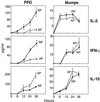Antigen-specific and persistent tuberculin anergy in a cohort of pulmonary tuberculosis patients from rural Cambodia
- PMID: 12032325
- PMCID: PMC124289
- DOI: 10.1073/pnas.062056099
Antigen-specific and persistent tuberculin anergy in a cohort of pulmonary tuberculosis patients from rural Cambodia
Abstract
Purified protein derivative (PPD) skin testing is used to identify persons infected with Mycobacterium tuberculosis (Mtb) and to assess cell-mediated immune responses to Mtb. However, lack of skin induration to intradermal injection of PPD or PPD anergy is observed in a subset of patients with active tuberculosis (TB). To investigate the sensitivity and persistence of PPD reactivity and its in vitro correlates during active TB disease and after successful chemotherapy, we evaluated the distribution of skin size induration after intradermal injection of PPD among 364 pulmonary TB patients in Cambodia. A subset of 25 pulmonary TB patients who had a positive skin reaction to mumps and/or candida antigens showed persistent anergy to PPD after successful completion of TB therapy. Strikingly, in vitro stimulation of T cells from persistently anergic TB patients with mumps but not PPD resulted in T cell proliferation, and lower levels of IL-2 and IFN-gamma and higher levels of IL-10 were detected in PPD-stimulated cellular cultures from PPD-anergic as compared with PPD-reactive pulmonary TB patients. These results show that anergy to PPD is antigen-specific and persistent in a subset of immunocompetent pulmonary TB patients and is characterized by antigen-specific impaired T cell proliferative responses and a distinct pattern of cytokine production including reduced levels of IL-2.
Figures



References
-
- Dye C, Scheele S, Dolin P, Pathania V, Raviglione M C. J Am Med Assoc. 1999;282:677–686. - PubMed
-
- Alvarez S, McCabe W R. Medicine (Baltimore) 1984;63:25–55. - PubMed
-
- Nardell E, McInnis B, Thomas B, Weidhaas S. N Engl J Med. 1986;315:1570–1575. - PubMed
-
- The World Health Report 2001 (2001) (W.H.O., Geneva), pp. 144–5.
-
- Tsicopoulos A, Hamid Q, Varney V, Ying S, Moqbel R, Durham S R, Kay A B. J Immunol. 1992;148:2058–2061. - PubMed
Publication types
MeSH terms
Substances
Grants and funding
LinkOut - more resources
Full Text Sources
Other Literature Sources
Medical

